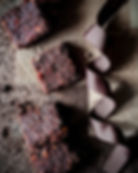- Moy's Gluten Free Kitchen
- Apr 16, 2021
- 3 min read
Updated: Sep 22, 2021
Where I live there are quite a few street vendors and retail food outlets selling wraps of all kinds. Some wraps are thick somewhat like pita bread, others are thin with a slight crisp on the edges. What stays fairly consistent wherever you buy is that the wrap must be flexible enough so that when filled it does not break and the wraps should not get soggy too quickly. These gluten free and vegan cassava wraps meet those 2 main criteria.
Cassava flour is perfect here because it is naturally a "sticky" type of flour. Doing the flour scald recommended in the recipe adds extra elasticity and chew to the wraps. The wraps also hold up really when they are filled. I prefer thinner wraps for their flexibility and because I do not want more flour than filling. These wraps are also distinct from any of the roti recipes I've shared, but I suppose you could use either somewhat interchangeably, even though roti is not as "bendy" as wraps.
With just one main type of flour, these wraps are also easier to budget for. You could even substitute the tapioca starch or the flaxmeal with an equivalent amount of cassava flour. However, I rather like the flaxmeal in this recipe for added fiber and because it holds moisture adding to the soft texture of the wraps.
On to the recipe...



Gluten Free and Vegan Cassava Flour Wraps Recipe
Ingredients
1¾ cup cassava flour
2 tbsp tapioca starch
2 tbsp flaxmeal
¼ tsp xanthan gum
¾ tsp salt
1/3 cup oil
¾ – 1 cup water (room temp or lukewarm)
1 cup of hot water
tapioca starch to roll out the dough
Directions
Bring a cup of water to boil. To ¼ cup of the cassava flour add ½ cup of hot water and stir until the cassava looks like a ball of jelly. If you need more boiling water add 1 tablespoon at a time so that all of the cassava flour is mixed properly. Set this aside to cool. You will not need hot water from here on
While you are waiting for the cassava flour scald mix to cool, add the rest of the dry ingredients to a bowl and mix well
Add the cooled cooked flour and other wet ingredients but not the water to the dry ingredients and begin to mix or knead. Using the lukewarm water add it to your dough in small increments until it holds together and is fairly smooth. The dough should be somewhat sticky and not stiff, you may need more or less water than what the recipe specifies
Lightly flour your work surface.
Pinch off pieces of dough to form balls 3”- 3½” in diameter. Knead and roll the dough lightly around on the floured surface to form a smooth ball. Use a light touch and as little flour as possible. You can add a little oil to the palm of your hands while you work. Set the rounds aside on a greased surface or bowl and cover with a tea cloth or plastic wrap. Repeat the process with the remaining pieces of dough. Leave the rounds to rest for at least ½ hour
Once the dough has rested, heat a tawa, grill or skillet to moderate
Keeping the remaining pieces covered, on a lightly floured surface gently roll out one of the dough balls to your desired thickness. I roll mine to just less than 1/8” thick (which is thin). Turn the dough occasionally and add a little tapioca starch at a time to prevent the dough from sticking to the surface or tearing
Place the wrap on the tawa to cook. Small bubbles will appear and the edges of the wrap will set. The wrap will not colour as richly as it's wheat based relative. Once the edges are set and the wrap has pulled away from the tawa, flip and cook the other side. Brushing the wraps lightly with a little bit of oil as they cook, helps them to remain soft
Once the wrap has finished cooking stack on a plate and cover with a warm tea cloth or two
The wrap is best served warm. To store wrap and freeze immediately as it's cooled. Reheat and serve at once.



